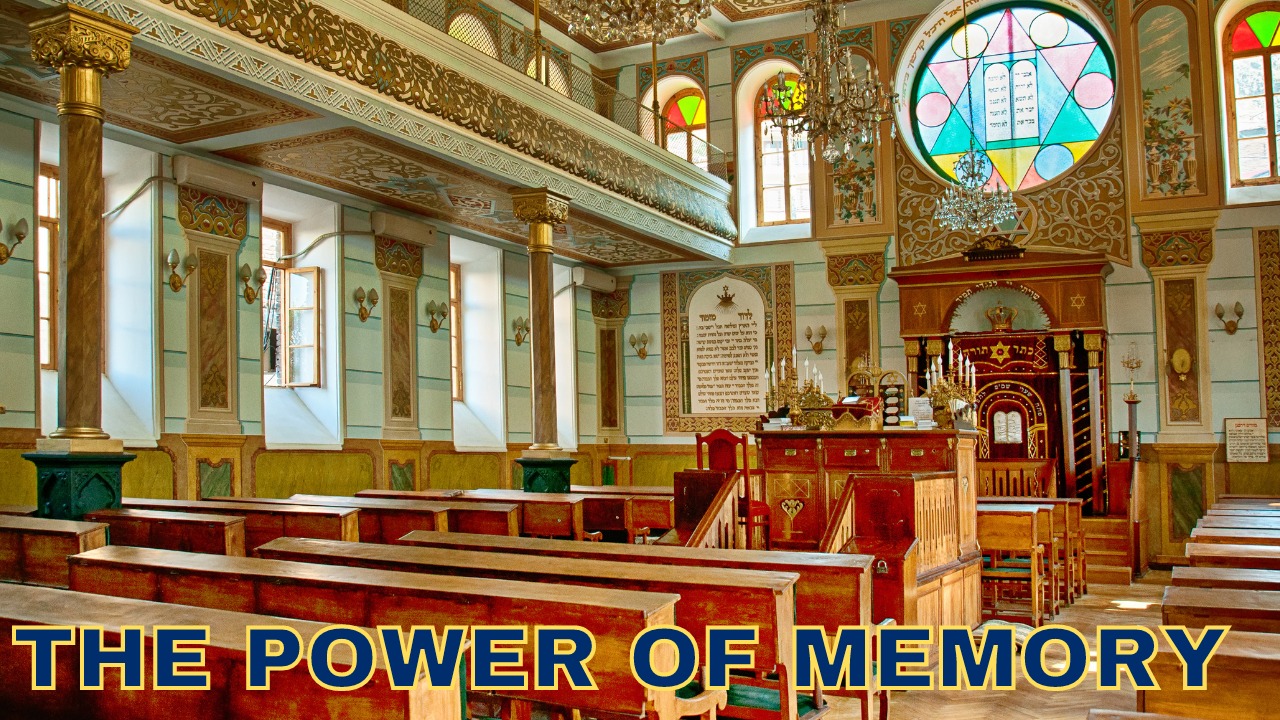THE POWER OF MEMORY AND PERSONAL EXPERIENCE

Jewish life and Jewish identity are inextricably bound up with the Jewish festivals cycle that runs through each calendar year. Every month of the Jewish year is connected to a holiday or a significant commemorative date — such as a fast day. These holidays and commemorative dates are the lifeblood of every Jew — the oxygen that gives being Jewish meaning and significance.
First and foremost is the religious connotation that accompanies each one of them, and the impact these connotations have on how we conduct ourselves on those days. For example, the Yamim Nora’im (usually translated as “Days of Awe,” although my preferred translation is “awesome days”) are intended to put us on a higher spiritual plane, to the extent that the entire preceding month of Elul has evolved into a kind of Yamim Nora’im bootcamp, with customs and traditions that aim to put us in the right frame of mind for Rosh Hashanah and Yom Kippur even before we get there.
Pesach is a festival of miraculous liberation and national identity, while Shavuot is the festival when we commemorate receiving the Torah from God at Mount Sinai. Sukkot is all about unbridled joy. Hanukkah celebrates the unlikely victory of a small band of the faithful against the seemingly insurmountable power of a mighty army, as well as the incredible rededication of the Temple in Jerusalem that followed, while the theme of Purim is miracles that occur even as events seem to unfold via natural means.
We also have days set aside for sadness and reflection — such as the ninth of Av, a fast day when we recall the destruction of two Jerusalem Temples. The ninth of Av also comes with a preliminary bootcamp period — this one is three weeks long and begins with another day of fasting: the seventeenth of Tammuz. The customs and traditions over this three-week period reflect our collective sadness coupled with an overt acknowledgment of the relationship breakdown between God and His chosen nation that resulted in the Temples’ destruction, and consequently, our resolute desire to right the wrongs of Jewish history.
But truthfully, there is far more to these festivals and fast days than just that. While Jewish life, in general terms, is governed by a preset calendar steeped in history and tradition, our personal lives as Jews are infused with an individual flavor that is far more subjective and idiosyncratic — and yet, this individual aspect is no less important, by any means. The foods, the prayers, the memories, the customs — all these elements of the festivals and the periods of the year when they occur form a powerful backdrop to our own experiences, no less powerful than the festival and fast-day associated laws mandated by the Talmud and Shulchan Aruch.
My own upbringing brimmed with these atmospheric foundations. And as a result, each year, as the Jewish festivals approach, or as we anticipate Shiva Asar b’Tammuz and Tisha b’Av, I find strength and meaning in recalling the foundations laid by the experiences of my youth and early adulthood.
Every Pesach, for example, I recall the Pesach seders with my grandparents — my mother’s parents, survivors of the Holocaust who hid from the Nazis for two-and-a-half years in a tiny room behind a false wall at the home of gentile friends in Rotterdam, Holland. I vividly remember walking with my Dutch grandfather to shul on yomtov — my grandparents always came to London from Holland for Pesach and Sukkot, and occasionally also for Yamim Nora’im.
I remember marveling at my grandfather’s determined expression and at his deliberate pace; he was a rock of faith despite the many challenges he had faced in his life. And even today, many decades later, and long after their passing, I feel my grandparents with me at every Pesach seder, and my grandfather still walks with me to and from shul.
One particular memory stands out more vividly than the others. In 1976, my family moved from Stamford Hill, an area in North London, to Golders Green, in North West London. Each year thereafter, for many years, we returned to Stamford Hill for Yom Kippur, where my grandfather — my father’s father — was the rabbi of a synagogue, and where he led the services for Kol Nidre, Mussaf and Ne’ilah. In 1983, my mother’s father was with us for Yamim Nora’im, and he decided to join us in Stamford Hill for Yom Kippur rather than remain in Golders Green, and throughout Yom Kippur I stood beside him as he prayed.
That year, we reached the Ne’ilah prayer early, and my father’s father — who was leading the services — decided to recite each Avinu Malkeinu out loud for it to then be repeated by the congregation, instead of just the limited selection of nine that are usually read out by the hazzan and then repeated. Avinu Malkeinu is a series of implorations, and their recitation is always highly charged even under normal conditions, but at the end of Yom Kippur, and with each one being recited aloud in unison, Avinu Malkeinu took on a whole new dimension.
Close to the end of Avinu Malkeinu is a set of four that are all connected to each other. They begin with “Avinu malkeinu, aseh lema’an harugim al shem kad’shecha” – “Our father, our king, do it for the sake of those who were killed for Your holy name.”
Suddenly, as he recited this first Avinu Malkeinu of the set out loud, my mother’s father began to sob uncontrollably. His whole body was shaking. Both his parents and most of his extended family had been murdered by the Nazis in the Holocaust, and in that moment, in those final minutes of Yom Kippur, their loss was so vivid to him, and so evocative, that he was overwhelmed with emotion, and this usually impassive man broke down and cried like a child.
We continued: Avinu malkeinu, aseh lema’an t’vuchim al yichudecha – “Our father, our king, do it for the sake of those who were slaughtered for Your oneness.” And then we all said out loud, in unison, Avinu malkeinu, aseh lema’an ba’ei ba’eish u’bamayim al kiddush sh’mecha – “Our father, our king, do it for the sake of those who were burnt and drowned for the sanctification of your name.” And as the congregation chanted these lines, my grandfather’s emotional epiphany became even more pronounced, his voice broken by racking sobs.
Finally, we reached the fourth Avinu Malkeinu in the set: Avinu malkeinu, nekom nikmat dam avadecha hashafuch — “Our father, our king, avenge the spilt blood of your servants.” For this, the last one in the series, my grandfather straightened up and responded with a full, strong voice — a piercing recitation. It almost seemed as if he was challenging God to give meaning to the death of his parents, whose only “crime” had been that they were Jews in the wrong place at the wrong time — resulting in their gruesome death at Sobibor death camp in May 1943.
Although it was more than 40 years after his parents’ murder, the wound was still fresh and raw, and as painful as ever. And evidently, my grandfather wanted God to know how he felt — truly, it is a moment I will never forget for as long as I live. In fact, I think of it every year on Yom Kippur when I say the words nekom nikmat dam avadecha hashafuch, I think of my mother’s father, shaking with emotion, alongside me, responding and repeating those words with all his might, not holding back. I also think of his parents, walking into the gas chambers, to be murdered in cold blood. And to top it all off, I think of my father’s father, also a victim of Nazi persecution, who lost his parents in Auschwitz, and who led the prayers that fateful Yom Kippur.
For me, each year, at that particular moment in the service, Yom Kippur is not just a generic day of worship or a holy day in the Jewish calendar. Rather, it is a deeply personal experience that ties into the experiences of my forebears, and my memories of them on Yom Kippur.
In fact, my Yom Kippur experience as a whole is an amalgamation of all the many Yom Kippur experiences I have had throughout my life. It includes the many people I have prayed with and the many places I have prayed at. It includes the tunes I have sung; it includes the highs, and it includes the lows; and it even includes all the different post-Yom Kippur fast-breaking meals I have shared with so many people and in so many settings. And each Yom Kippur I continue to create new experiences that act as the setting and foundation for the years that follow.
It goes without saying that this phenomenon is not just limited to Yom Kippur. Every significant Jewish date is loaded with memories and past experiences, and all of them feed into the “mother ship,” augmenting its efficacy and enhancing its meaningfulness.
I also remember that one year, on the first night of Sukkot, it just would not stop raining. My father, ever the optimist, refused to give up hope of making kiddush in the sukkah, and insisted that we wait until it stopped raining before we began eating. An hour or more went by, and we were all hungry, so, with my father’s reluctant consent, we began the meal indoors — but he was still utterly determined. He was so sure it would stop raining. Every few minutes he went outside to check if the rain had stopped — it was simply unthinkable to him that we wouldn’t make kiddush in the sukkah on the first night of the festival.
Eventually — long after we had finished eating — he came running in, his eyes gleaming. “It’s stopped raining,” he announced excitedly, and we all traipsed into the sukkah for kiddush and cake. My father just couldn’t stop smiling. He was like a child who’d received his favorite toy as a gift. And that’s exactly how he felt: that God had given him a gift — kiddush in the sukkah on the first night of Sukkot.
These memories and so many more turn each festival and each significant Jewish date into a combination of history, tradition, Jewish laws and customs, memories, nostalgia, and new experiences. And the result is so much greater than any one of those individual components.
Every wine stain on the pages of the Haggadah we use. Every forgotten High Holy Days schedule that we left tucked into the pages of the machzor. The special yomtov-connected drawings that our kids gave us when they were at pre-school that suddenly reappear at the relevant time of year. The smell of yomtov food cooking in the kitchen. Each one of these and so many more — too many to mention — are the kaleidoscope of our Jewish experience which add color, context, and meaningfulness to the festival experience, augmenting the practical aspects of the festivals and notable Jewish dates that punctuate our lives.
My intention in having combined all the festivals into one book is to offer the full array of our Jewish experience in one volume — allowing you, the reader, to ride the roller coaster of Jewish experience without having to wait for each significant date to come around. The flavors and evocations of every date in the Jewish calendar are here for you to savor and ready for you to enjoy.
Rabbi Dunner’s new book, “Hearts & Minds II: An Original Look at Jewish Festivals and Significant Jewish Dates,” is published by Otzrot Books, and is available on Amazon and at Jewish bookstores.

